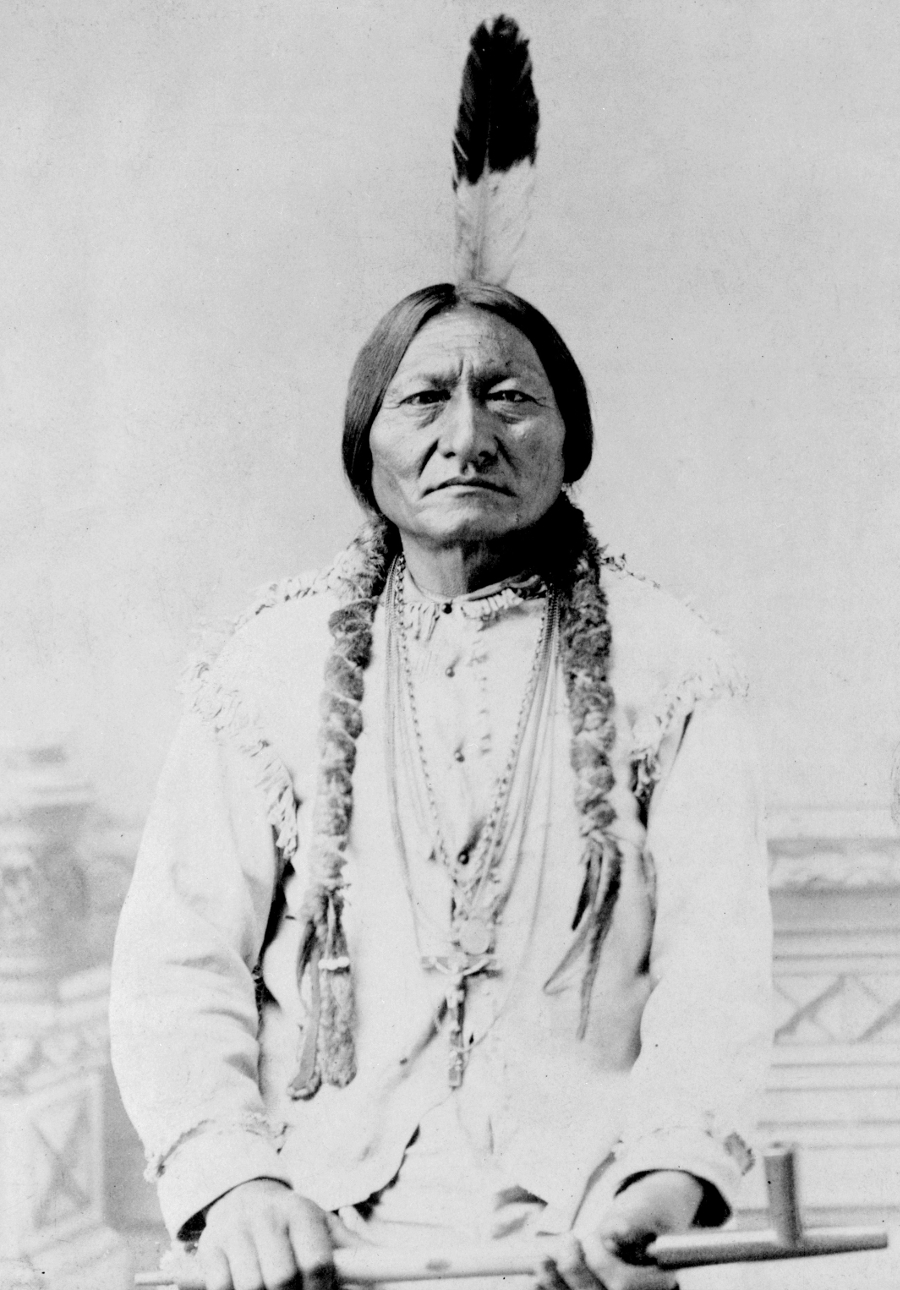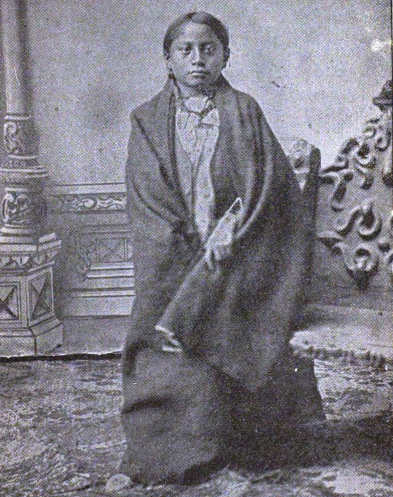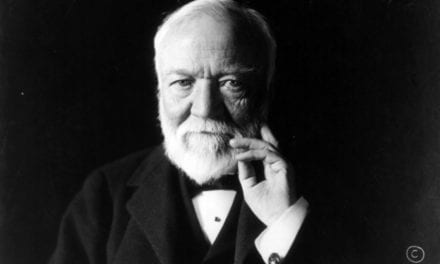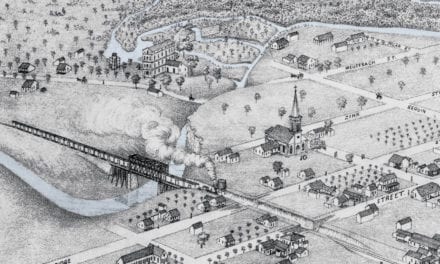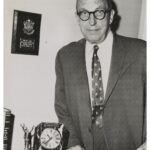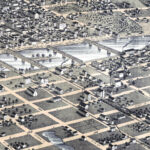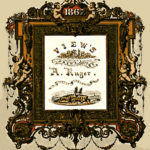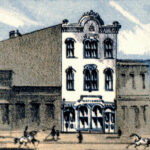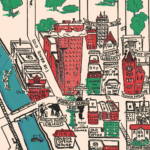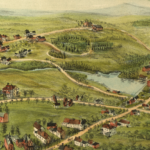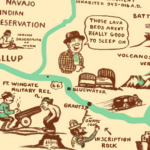The general consensus of opinion is that Sitting Bull was born about 1830, at a camp on Willow Creek, near the mouth of the Cheyenne River, and near old Fort George. He was the son of Jumping Bull, a Sioux chief, and a nephew of Four Horns and Hunting His Lodge, who were also chiefs. His father was, for an Indian, a wealthy man, and was “the owner of a great many ponies in four colors.” Here are a few other interesting facts about the man known as Sitting Bull.
1. He was originally called “Sacred Standshot”
Sitting Bull was at first called Sacred Standshot, and soon became a famous hunter. At ten years old he was famous throughout his tribe as a killer of buffalo calves. As his father was rich and did not need the meat, the boy gave away all the game he killed to the poorer members of the tribe, and thus gained great popularity.
2. Until he got injured in a fight with another Indian
When he was thirteen years old his father died, and from then on he “killed buffaloes and fed his people.” The next year he fought with and killed a young Indian a few years older than himself, and his name was then changed to “Lame Bull” or “Sitting Bull” on account of a wound he received which made him permanently lame.
3. He had five wives, all with very interesting names
He was five times married, one of his wives dying soon after the wedding. The other wives were named “She That Was Seen by the Nation”, “She That Had Four Robes”, “Snow on Her” and “Light Hair”. They bore twelve children in all, including a pair of twins – a most unusual thing among Indians. (Source)
4. His son – Crow Foot – surrendered for him
When, after the Custer massacre, Sitting Bull surrendered at Fort Buford, one of his sons, a young man of 18, was at school in Chicago. Another, a boy of six years, Crow Foot, was with the chief, and at the formal pow-wow the chief put his heavy rifle in the little fellow’s hands and ordered him to give it to Major David Brotherton, saying:
“I surrender this rifle to you through my young son, whom I now desire to teach in this way that he has become a friend of the whites. I wish him to live as the whites do and be taught in their schools. I wish to be remembered as the last man of my tribe who gave up his rifle. This boy has now given it to you, and he wants to know how he is going to make a living.” (Source: The Wheeling Intelligencer, West Virginia, July 22, 1881)
5. He was a medicine man, not a warrior
Sitting Bull is commonly thought of as a warrior, but he was not. He was a “medicine man;” which means that he fulfilled three professions of priesthood, medicine and law. He inherited the chieftainship of a part of the Sioux tribe from his father, but his remarkable power over the Sioux nation was due to his claims of miracle-working and talents as a politician. He played upon the religious beliefs of the Sioux with his “medicine” or miracles until they believed him to possess supernatural powers and were ready to follow his lead in everything.
Some other chiefs inherited wider authority, such as Red Cloud and Crazy Horse, but when Sitting Bull made an appeal to the religious fanaticism of the people, there was no withstanding him.
To the day of his death he was the principal chief of all the Sioux and the leader of 6,000 braves, who at all times were ready at his command to commit any crime from murder up or down. As a medicine man he had the lower members of his tribe abjectly subservient, and through them he led a united front against the “white men” overtaking their ancestral land.
6. The Sioux People Feared Sitting Bull
The following authentic story illustrates how much Sitting Bull was feared in his tribe. In January, 1876, when Major Alderson was Indian agent at Fort Peck, he received a letter from the government which he was ordered to convey to Sitting Bull, commanding that Sitting Bull come into the reservation or consider himself an outlaw.
Alderson was in a quandary. His instructions were clear, but he couldn’t find anyone brave enough to deliver the message. He sent for Sitting Bull, but Sitting Bull said he was too busy to visit Fort Peck; so the letter had, if possible, to be sent to him.
A gentleman of unquestioned bravery, who could speak the Indian language fluently, was sent for and offered $500 and an escort if he would take the letter to the Indian camp. After consideration, however, the offer was declined. “If I could see Sitting Bull myself,” he said, “I believe my life would be safe, but he would cut my ears off.”
Finally a party of Indians were dispatched with the mission after it had been very carefully explained and interpreted. After an absence of five days they returned and confessed that their hearts “were not big enough” to carry such a message to Sitting Bull. The message was never conveyed to the chief.
7. White People Feared Sitting Bull
Sitting Bull first became widely known to the white people of America in 1866. In that year he led a terrible raid against the settlers and military post at Fort Buford. His path was marked with blood and made memorable by ruthless savagery. As the marauders approached the fort, the commandant of the post shot and killed his own wife, at her earnest request, to save her from the more cruel fate of falling into the hands of the Sioux.
8. Sometimes, without reason
And yet he was often magnanimous, from an Indian’s point of view. For example, it is told that in 1873 he was coming with a small band to Fort Peck, and he found a short distance from the fort, three white men lying asleep under a tree. His followers wanted to kill and scalp them on the spot, and secure their arms and horses, but the chief would not allow it, and stood over them till all his band had passed.
Next day in the fort, Sitting Bull walked up to the leader, Mr. Campbell, and shook hands. Campbell said he did not know him. “I am Sitting Bull,” was the reply, “and I gave you your life yesterday.” “How was that?” said Campbell. The chief proceeded to explain in a manner that satisfied Campbell that what he said was true, and, in gratitude, offered rewards, but Sitting Bull declined all such offers, and after another handshaking, strode away.
9. He reached the peak of his fame and power during the Sioux war of 1876
Sitting Bull reached the zenith of his fame and power in the Sioux war of 1876. The cause of the war was the discovery of gold and silver in the Black Hills. This was then an almost unknown region, encircled by the famous Bad Lands. Even the Indians rarely went there, regarding it as a “medicine country,” or haunted region.
But when it became known that precious metals were to be found there, pressure was brought to bear upon the Government, and an expedition was sent. Ostensibly it was a military reconnaissance. In reality, it was a prospecting party. It was led by General George A. Custer, and consisted of more than 1,200 men, with sixty Indian guides. The expedition found the hills rich with precious metals, and from then on there was a great rush of miners and other settlers. This greatly annoyed the Indians, to whom the region belonged. Red Cloud, Spotted Tail, and other chiefs visited Washington to protest the invasion, which was a clear violation of existing treaties. The government agreed to keep the prospectors out, but failed to do so, and by the fall of 1875 there were a thousand miners at work in the Black Hills.
The Indians demanded payment for the land of which they were being robbed, and a government commission visited them to agree on terms. But the commission returned with its work undone, and reported that it would be impossible to settle the matter without force. The Indians too, came to the conclusion that they would have to fight for their rights. This caused the Indians to desert Red Cloud and the other more conservative chiefs, and to flock around Sitting Bull, who had all along been defiant towards the government and opposed parting with the land at any price.
10. He didn’t run from a fight
For many years a number of hostile Sioux had been roaming the northern portion of Dakota under the leadership of Sitting Bull, Crazy Horse, and a few other chiefs. In 1874 their number was estimated at 7,000, but subsequently about 4,000 of these Indians went into reservations at Standing Rock, Spotted Tail, and Cheyenne River reducing the number who can be properly called hostile to about 3,000. The War Department estimated Sitting Bull’s band at about 3,500 Indians. All attempts to induce these Indians to go upon reservations had thus far failed.
A message was sent to Sitting Bull and the chiefs who were operating with him, ordering them to report to their reservations before the 1st of January, 1876 the alternative being that if they did not the United States would wage war against them. The Sioux paid no attention to the orders, and under the leadership of Sitting Bull they refused to leave their camps on the Big Horn and Tongue Rivers, in the Valley of the Yellowstone.
The government dispatched scouts into Big Horn country with a peremptory notice of ejection, and the threat that if they should not heed the summons, troops would be sent into the valley to drive them out. Sitting Bull received the message with contempt, saying:
“When you come for me you need bring no guides. You will easily find me. I shall be right here. I shall not run away.”
A vigorous campaign was accordingly organized in the Spring of 1876 against the tribes of the Sioux. What followed is known as “The Battle of the Little Bighorn,” or “Custer’s Last Stand.”
11. God guided Sitting Bull during Custer’s last stand
Speaking of The Battle of the Little Bighorn, Sitting Bull said,
“There was a Great Spirit who guided and controlled that battle. I could do nothing. I was sustained by the Great Mysterious One (pointing upwards with his forefinger). I am not afraid to talk about that. It all happened – it is passed and gone. I do not lie, but do not want to talk about it. Low Dog says I can’t fight until some one lends me a heart. Gall says my heart is no bigger than that (placing one forefinger at the base of the nail of another finger).
We have all fought hard. We did not know Custer. When we saw him we threw up our hands, and I cried, ‘Follow me and do as I do.’ We whipped each other’s horses, and it was all over. There was not as many Indians as the white man says. They are all warriors. There was not more than two thousand. I did not want to kill any more men. I did not like that kind of work. I only defended my camp. When we had killed enough, that was all that was necessary.
12. He lived in Canada as a fugitive
After the Battle of Little Big Horn, it was at first reported and widely believed that Sitting Bull himself had been killed in that last desperate fight with Custer. A number of witnesses who had met Sitting Bull attempted to positively identify the body as the famous chiefs, but none were successful. It soon became known that Sitting Bull and many of his comrades and followers had made their way northward across the border in the British Northwest Territory, and were being hosted by the British at Fort Walsh.
The flight into Canada was ruinous to Sitting Bull. The British Government gave them refuge and protection, but that was all. It gave them no supplies, and forbade them to make raids across the United States border. The land around Fort Walsh was barren, and game was scarce. During the three of four years they lived in Canada the Indians suffered terribly for food and clothing. Their women and children died of want, and the men hunted in vain. They gradually drifted toward starvation.
In the meantime Dakota was fast becoming civilized, and the buffalo and other game were disappearing from the old hunting ground of the Sioux. Sitting Bull eventually admitted to his people that he and his followers could not return except as prisoners, and as a consequence dissatisfaction became widespread. He lost his power and many Indians returned to the United States to live in reservations. Sitting Bull, however, stubbornly held out, hoping that the Canadian authorities would make terms for him with the Government at Washington. In this he was disappointed, and he found himself deserted by all but a few dozen of his old followers.
Source: The red record of the Sioux. Life of Sitting Bull and history of the Indian war of 1890-91 [Amazon]. The book was published in 1891 by Willis Fletcher Johnson, a diplomatic editorial writer for The New York Tribune.

